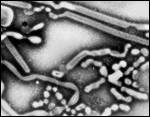On This Page:
The Three Types of Influenza Viruses
Influenza A, B, and C
Influenza types A or B viruses cause epidemics of disease
almost every winter. In the United States, these winter influenza
epidemics can cause illness in 10% to 20% of people and are
associated with an average of 36,000 deaths and 114,000 hospitalizations
per year. Getting a flu shot can prevent illness from types
A and B influenza. Influenza type C infections cause a mild
respiratory illness and are not thought to cause epidemics.
The flu shot does not protect against type C influenza.
Influenza type A viruses are divided into subtypes based on
two proteins on the surface of the virus. These proteins are
called hemagglutinin (H) and neuraminidase (N). The current
subtypes of influenza A viruses found in people are A(H1N1)
and A(H3N2). Influenza B virus is not divided into subtypes.
Influenza  A(H1N1),
A(H3N2), and influenza B strains are included in each year's
influenza vaccine. A(H1N1),
A(H3N2), and influenza B strains are included in each year's
influenza vaccine.
Related information on Influenza A(H1N2) can be found at:
Transmission of Influenza Viruses from
Animals to People
Influenza A viruses are found in many different animals, including
ducks, chickens, pigs, whales, horses, and seals. Influenza
B viruses circulate widely only among humans.
Influenza A viruses are divided into subtypes based on two
proteins on the surface of the virus: the hemagglutinin (H)
and the neuraminidase (N). There are 15 different hemagglutinin
subtypes and 9 different neuraminidase subtypes, all of which
have been found among influenza A viruses in wild birds. Wild
birds are the primary natural reservoir for all subtypes of
influenza A viruses and are thought to be the source of influenza
A viruses in all other animals. Most influenza viruses cause
asymptomatic or mild infection in birds; however, the range
of symptoms in birds varies greatly depending on the strain
of virus. Infection with certain avian influenza A viruses
(for example, some strains of H5 and H7 viruses) can cause
widespread disease and death among some species of wild and
especially domestic birds such as chickens and turkeys.
Pigs can be infected with both human and avian influenza viruses
in addition to swine influenza viruses. Infected pigs get symptoms
similar to humans, such as cough, fever, and runny nose. Because
pigs are susceptible to avian, human and swine influenza viruses,
they potentially may be infected with influenza viruses from
different species (e.g., ducks and humans) at the same time.
If this happens, it is possible for the genes of these viruses
to mix and create a new virus. For example, if a pig were infected
with a human influenza virus and an avian influenza virus at
the same time, the viruses could mix (reassort) and produce
a new virus that had most of the genes from the human virus,
but a hemagglutinin and/or neuraminidase from the avian virus.
The resulting new virus would likely be able to infect humans
and spread from person to person, but it would have surface
proteins (hemagglutinin and/or neuraminidase) not previously
seen in influenza viruses that infect humans. This type of
major change in the influenza A viruses is known as antigenic
shift. Antigenic shift results when a new influenza A subtype
to which most people have little or no immune protection infects
humans. If this new virus causes illness in people and can
be transmitted easily from person to person, an influenza pandemic
can occur.
While it is unusual for people to get influenza infections
directly from animals, sporadic human infections and outbreaks
caused by certain avian influenza A viruses have been reported.
For more information see: Avian
Influenza Infections in Humans.
How the Flu Virus Can Change - "Drift" and "Shift"
Influenza viruses can change in two different ways.
One is called "antigenic drift." These are small changes in the virus
that happen continually over time. Antigenic drift produces new virus strains
that may not be recognized by the body's immune system. This process works
as follows: a person infected with a particular flu virus strain develops antibody
against that virus. As newer virus strains appear, the antibodies against the
older strains no longer recognize the "newer" virus, and reinfection
can occur. This is one of the main reasons why people can get the flu more
than one time. In most years, one or two of the three virus strains in the
influenza vaccine are updated to keep up with the changes in the circulating
flu viruses. So, people who want to be protected from flu need to get a flu
shot every year.
The other type of change is called "antigenic shift." Antigenic shift
is an abrupt, major change in the influenza A viruses, resulting in new hemagglutinin
and/or new hemagglutinin and neuraminidase proteins in influenza viruses that
infect humans. Shift results in a new influenza A subtype. When shift happens,
most people have little or no protection against the new virus. While influenza
viruses are changing by antigenic drift all the time, antigenic shift happens
only occasionally. Type A viruses undergo both kinds of changes; influenza
type B viruses change only by the more gradual process of antigenic drift.
More Information
|